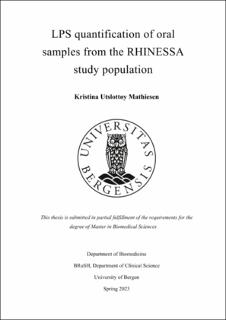| dc.description.abstract | The human immune system defends the body against threats through a complex network of organs, cells, and proteins. It has two subsystems: the innate immune system provides immediate defense, while the adaptive immune system responds specifically to encountered pathogens. Among these pathogens, bacteria hold particular significance. Bacteria are diverse single-celled organisms characterized by their relatively simple cellular structure. They can be broadly classified as Gram-negative or Gram-positive based on the composition of their cell walls. Gram-negative bacteria have a complex structure with an outer membrane and lipopolysaccharides (LPS). The structural configuration of the lipid A domain within LPS significantly influences the interactions with the host immune system, with certain lipid A variants demonstrating higher potency compared to others. Given the substantial connection between the oral microbiome and the overall systemic health of individuals, one of the primary objectives of this master's project was to investigate the levels of LPS in saliva samples collected from adult participants from the community-based generation study Respiratory Health in Northern Europe, Spain, and Australia (RHINESSA), Bergen study center. Limulus Amoebocyte Lysate (LAL) assay is a commonly used technique to determine bulk LPS concentration in samples. However, the extent to which the LAL assay can accurately detect the various lipid A structures remains uncertain, and regrettably, the assay lacks the capability to discriminate between specific lipid A variants. We aimed to evaluate the suitability of the LAL assay for measuring LPS levels in samples obtained through two distinct collection methods (method 1: use of a commercial kit (Norgen); method 2: no kit) as part of a pilot project. Furthermore, we sought to explore the association between gingival and salivary LPS-producing microbiota assessed by 16S rRNA sequencing and salivary LPS activity measured by LAL assay. For this master project, the samples were either collected on-site specifically for the pilot project or obtained from the larger RHINESSA study. The RHINESSA study is a longitudinal, multi-generational research initiative conducted in Europe and Australia, focusing on environmental and genetic factors associated with lung health. Two different LAL assay kits were employed to measure LPS concentrations. The pilot project revealed that both LAL assays was unsuitable for samples collected using the commercial kit. Consequently, when conducting further investigations on the RHINESSA samples, the samples collected using the kit were excluded from analysis due to resource constraints and interference. DNA extraction was performed on the RHINESSA saliva samples, followed by sequencing and bacterial community profiling based on the 16S rRNA gene. The DNA and LPS concentrations of the samples exhibited non-Gaussian distributions, and Mann-Whitney tests unveiled no significant differences between genders or known factors related to oral diseases and LPS concentration. However, male participants exhibited higher LPS levels than females, which could potentially be attributed to factors such as tobacco use, Community Periodontal Index (CPI) score, and oral hygiene practices. Analysis of the bacterial taxonomy and lipid A annotation of gene sequences obtained from the saliva samples revealed a low ratio between bacteria producing hexa-acylated lipid A and those producing penta-acylated lipid A, possibly due to a healthy study population. Similar results were obtained from the analysis of previously collected gene sequences from gingival crevicular fluid (GCF) samples obtained from the same participants. The bacterial composition and abundance in both saliva and GCF exhibited similarities to previous studies in the field. Results from correlation analysis demonstrated a positive correlation between the abundance of penta-acylated bacteria and the concentration of LPS in the samples, while a negative correlation was observed between the abundance of hexa-acylated bacteria and LPS concentration. This finding, in conjunction with the previously identified low hexa:penta ratio, suggests that the potential pro-inflammatory effects of hexa-acylated LPS-producing oral bacteria may be counteracted by the prevalence of more abundant penta-acylated LPS producers. Overall, the analysis of bacterial microbiota utilizing techniques such as 16S rRNA sequencing and the LAL assay for measuring LPS concentration can provide valuable insights into microbial ecology and facilitate a deeper understanding of the complex interplay between environmental and genetic factors that influence human health. | |
